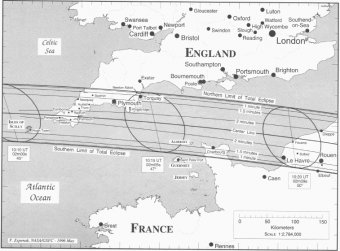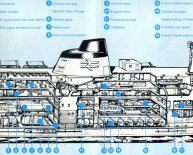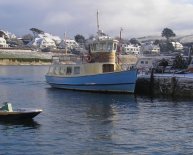
Home Observatory UK Falmouth United Kingdom

Introduction
The first total solar eclipse visible from the United Kingdom mainland for more than 70 years occurs on the morning of Wednesday, 11 August 1999, soon after 11:00, a.m. Previous total eclipses visible from the UK this century were those of 29 June 1927 and 30 June 1954; the latter, however, was visible only from the northernmost part of the Shetland Islands. Although the partial phase of the eclipse will be visible from the whole of the British Isles, the path of totality across the country is rather short, being limited to a strip which crosses the Isles of Scilly, most of Cornwall except the northern part, southern Devon and Dorset as far as Torquay, and the Channel Island Alderney.
Figure 1: Total eclipse track, after Espenak & Anderson (1997). (Click on the image for high quality figure.)
Weather prospects for viewing the eclipse are only moderate in the UK, and those wishing to be certain of seeing the event are advised to travel to a part of Europe where cloud is less likely to be a problem.
Eclipse Path
Anyone wishing to view the total eclipse at its best is strongly advised to travel to a place where the Moon completely covers the Sun, as only there will the full beauty of the event be seen. The track of the Moon's shadow on the Earth, known as the path of totality, will pass over many towns and cities of Europe and Asia, thus giving many millions of people the opportunity to witness this rare and wonderful spectacle. Some of the towns include Cherbourg and Reims in France, Stuttgart and Munich in Germany, Timisoara and Bucharest in Romania, Sivas and Diyarbakir in Turkey, Irbil and As-Sulaymaniyah in Iraq, Esfahan in Iran, Karachi in Pakistan, and Baroda and Akola in India.
The maximum possible duration of the total eclipse is 2m 23s, occurring near Rimnicu-Vilcea in Romania. The duration of the total phase of the eclipse ranges from 2m 2s at Falmouth, England, 2m 13s at Metz, France, 2m 17s at Stuttgart, Germany, 2m 7s at Sivas, Turkey, 1m 33s at Esfahan, Iran, 1m 13s at Karachi, Pakistan to 52s at Chandrapur in India.
The times of the total eclipse for selected United Kingdom, Western and Eastern European towns and cities are given in Times are given according to British Summer Time (BST); add 1 hour to obtain local times in France, Germany, Austria, Hungary and Romania. The start of the partial phase of the eclipse is denoted `first contact', while `second contact' denotes the start of totality. The total phase finishes a couple of minutes later at `third contact, ' while the remaining partial phase of the eclipse can then be viewed up to eclipse end at `fourth contact'. The times of the eclipse for towns and cities where only a partial eclipse is visible are given in The northern limit of the eclipse path lies some 70 miles off the coast of southwest Ireland. Consequently, no place in Ireland will experience a total eclipse. At Cork, for instance, the eclipse magnitude will be 97%.
Although Cornwall has some of the best summer weather in England, there is still only a 45% probability of it being clear there at the time of the eclipse. The probability of seeing the eclipse increases the further east one goes. For instance, Munich has a probability of 50%, Bucharest 60%, Sivas in Turkey 75%, and Esfahan in Iran 95%.
Figure 2: Path of totality across Europe, after Espenak & Anderson (1997). (Click on the image for high quality figure).
Table 1: Times of the eclipse to the nearest second (BST) for selected towns and cities lying on the path of totality.
| 1st Contact | 2nd Contact | 3rd Contact | 4th Contact | |
| Country | Town | Totality
Begins |
Totality
Ends |
Duration
of Totality |
| England | Bodmin | 1m 12s | ||
| Salzburg |
| Start | Maximum | End | Magnitude
(%) |
| Belfast | 97 | ||
| Dublin | 92 | ||
| London | 90 |
Eclipse Types
The Earth orbits the Sun making one complete revolution in one year. Similarly, the Moon is in orbit around the Earth. Occasionally all three bodies, Sun, Moon and Earth lie in a straight line. As it happens, the angular diameters of the Sun and Moon are very nearly the same. The Sun is about 400 times larger than the Moon, but is also about 400 times further away. When all three bodies, Sun, Moon and Earth lie in a straight line with the Moon in the centre, the Moon will completely cover the Sun and we have the phenomenon of a solar eclipse.
Figure 3: How eclipses occur. The Sun (at left) casts a shadow of the Moon on to the Earth (at right). The diagram (not to scale) illustrates the three different types of solar eclipse.
In practice, the angular diameter of the Moon varies depending on its distance from the Earth. For a total eclipse to occur, the Moon's angular diameter must be greater than that of the Sun. The length of totality depends on how much larger than the Sun the Moon is, with the maximum possible duration of totality being about 7m 30s. Occasionally, the Moon is too far away to completely cover the Sun, and in this case the eclipse is called annular. The various types of solar eclipse are illustrated in Figure 3.
Safety
Permanent damage will be caused to the retina of the eye if proper precautions are not taken while observing the Sun. Injuries to the retina can occur without pain and the results may not be noticeable for some hours after the damage has been done. Viewing a partial solar eclipse, annular solar eclipse, or the partial phase of a total solar eclipse should not be attempted without some form of eye protection or the use of an appropriate observing method.
Never stare at the Sun. Even if only 1% of the Sun's disc is visible, it is still bright enough to cause damage. Children, especially, should be well supervised.



